“Luftwaffe in 45. Recent flights and projects. Continued. Part of 5
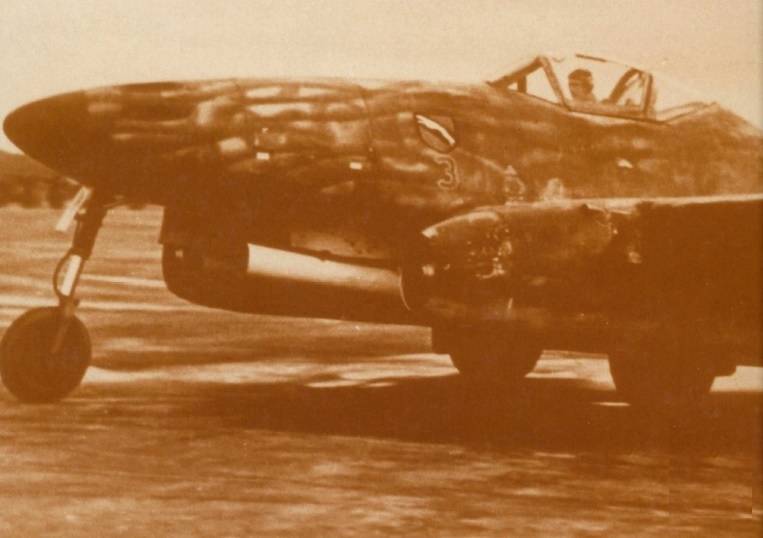
Aircraft FW-190 with Panzerblitz and Panzerschreck
April 9, 1945 command 6 air fleet to reduce losses from the impact of enemy fighters, it gave its pilots the order to strike at enemy ground forces from a minimum height, for which, after takeoff, German pilots should keep at a minimum height and strike only at lightly armored or unarmored targets, which gave hope for some success ... However, the command of the fleet knew that they would quickly install all aviation parts of missile launchers are unlikely to succeed due to enemy actions. Further, it was planned to transfer to the assault air group 1 / SG 9 of numerous squadrons armed with aircraft capable of carrying Panzerblitz and Panzerschreck missiles.
This concept, which was based on previously achieved success, extended to other squadrons. It was planned to equip the strike aircraft with rocket launchers, as well as pilot training. Now it concerned not only pilot-instructors, but also ground staff at the airfields in Erding, Manching and other cities. 11 April 1945 not only the air groups equipped with attack aircraft, but also numerous air groups of fighters took part in air strikes against the enemy. In particular, 2 / JG 3, 3 / JG 6, 1 / JG 52 and 4 / JG 51, the planes of which were to strike the enemy with strikes or accompany strike aircraft. The next day, the High Command of the Luftwaffe fleet 6 ordered air strikes to disrupt the preparation of the Soviet offensive in front of Unien.
An important role was given to squadrons of aircraft armed with Panzerblitz missiles, which were supposed to strike at the Soviet forces that had broken through in the direction of the Reich capital tanks... On April 14, 1945, the assault aviation squadron 3 / SG 4 still had 31 FW-190 F-8 and F-9 at its disposal, of which 21 were serviceable. Of the 23 FW-190 aircraft of the assault squadron 1 / SG 77, 12 aircraft could carry Panzerblitz missiles, of which 10 were serviceable. In the 2nd air group of this assault squadron, of 9 aircraft capable of carrying Panzerblitz missiles, seven were ready to departures. In total, the 9th Squadron of the SG 77 assault squadron had 13 FW-190 F-8 aircraft capable of carrying Panzerblitz missiles. The main problem was still the lack of fuel, which often made it impossible to perform test flights after the aircraft had been repaired. Serviceable aircraft stood idle for a long time on the outskirts of airfields, and were mainly destroyed by Allied aircraft, which were striking German airfields from low altitudes.
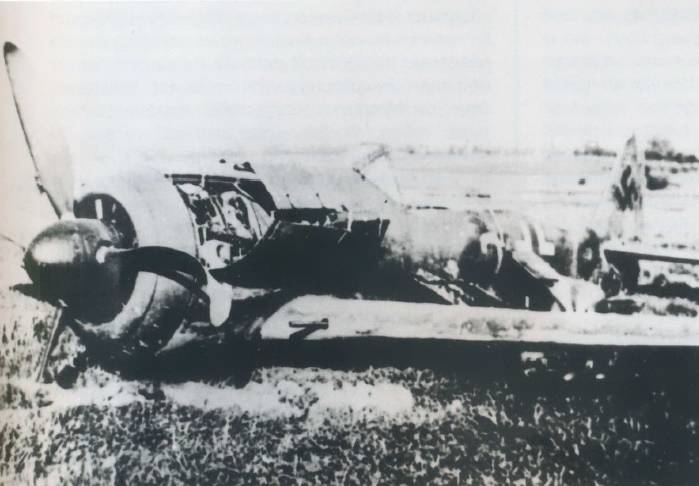
A large number of aircraft FW-190 F-8 with anti-tank missiles were shot down by enemy enemy anti-aircraft artillery, in an ever increasing number attached to tank formations
Despite the heavy losses in the conditions of the overwhelming superiority of the enemy, battles with the use of German assault aircraft continued to be fought.
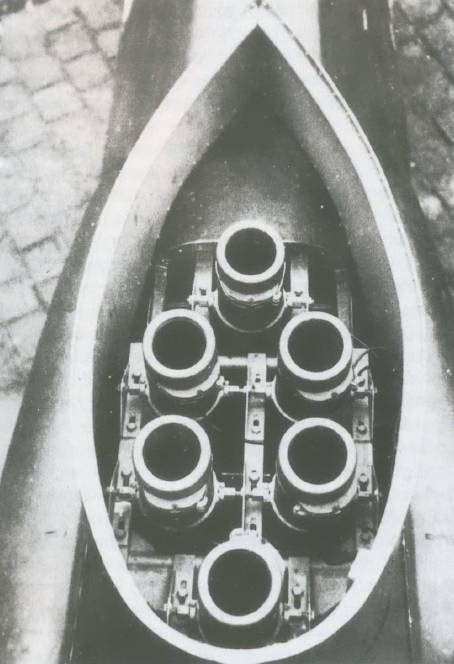
Shortly before the end of the war, Förstersonde’s SG 113A anti-tank weapon system was ready for use against tanks.
14 April 1945. 42 German attack aircraft and fighter struck the Russian tanks, advancing on Reichsautoban in the area between Breslau and Lienit, having hit the attacked targets. 15 April squadron 9 / SG 4, consisting of seven FW-190 F-8 aircraft during the very first attack fired thirty-six Panzerblitz missiles on T-34 tanks, as a result of which four tanks were set on fire. During the second attack, three more T-34 tanks were destroyed. During the subsequent attack, carried out on the same day, the FW-190 F-8 trio launched another 16 Panzerblitz missiles, achieving hits in the T-34 tank and a self-propelled gun. In the next three attacks, 32 anti-tank missiles were launched, destroying four T-34 tanks. 15 April 1945, after retaliatory attacks by Soviet fighters, five German aircraft did not return to their airfields. One of the most successful measures with the use of Panzerblitz missiles was an operation against the Soviet troops at Koberwitz (Köberwitz) 16 in April 1945, when 12 heavy Soviet tanks were destroyed, another tank was damaged, and three artillery positions were also attacked. However, during this operation, six German aircraft, including five FW-190 F-8 with Panzerblitz anti-tank missiles, due to technical problems, were forced shortly before approaching enemy units to withdraw from strikes. Five more aircraft for several reasons, mainly due to problems with the launch systems, were also forced to interrupt participation in the operation. Despite this, the 12 pilots of the 9 / SG squadron 4 were able to launch Panzerblitz missiles at the artillery positions of the Soviet troops and a group of about forty vehicles. Four more German planes attacked the enemy train. In total, during 16 on April 1945, 453 German aircraft, including 51 missile-carrying aircraft, took part in the air operations on the Eastern Front. During these operations, the Soviet anti-aircraft artillery shot down two FW-190 F-8 aircraft from the 3 / SG 4 air group, while the wounded pilots were able to avoid captivity. 17 April 8 F-190 F-8 aircraft struck in the area of the breakthrough of the Soviet troops on the front line between Brünn and Troppau. In the course of this strike, allegedly, one enemy heavy tank was destroyed and one SPG was damaged. In addition, 22 unarmed enemy vehicles were attacked. The pilots from the 2 / SG 2 air group during the attacks successfully covered the place of the accumulation of enemy tanks and vehicles under Weißwasser. Bombs and missiles "Panzerblitz" hit a large number of enemy vehicles. For a short time, these attacks led to the cessation of the movement of Soviet units in the attacked area of the Reichsautobahn.
In addition to the Panzerblitz missiles, the Panzerschreck missiles, which are easy to manufacture, were used as defensive weapons. Launcher lower right under the wing
According to German fighter pilots and attack aircraft, five Soviet aircraft were shot down during the strike. 18 April 15 pilots of the 3 / SG 4 air group, using Panzerblitz missiles, attacked moving Soviet tanks southeast of Cottbus and Spremberg. 25 FW-190 F-8 squadrons 9 / SG 7 under Weissenberg (Weißenberg) and south of Spremberg (Spremberg) hit the fragmentation bombs and missiles "Panzerblitz". 15 from the existing 72 FW-190 aircraft of the 2 / SG 2 aviation group attempted to hit the enemy’s heavy tanks and thereby reduce the onslaught on the German units. 18 April 59 capable of carrying “Panzerblitz” missiles and German aircraft bombs struck a missile-bombing attack, hitting 27 tanks and 6 ACS of the enemy, and Fedlerfelhebel Feller from the X-NUMX anti-tank squadron of 10 (Pz) I’re running on I’d running I’d working on I’ve left I’m not working with I think that I’m carrying X-guns and X-Numx tanks and 2 I-6s. the adversary. However, due to the enemy’s strong air defense, the 23 pilot did not return to their airfields. 19 On April 6, the FN-190 F-8 and F-9 airplanes of the 3 / SG 4 air group delivered a significant blow to the enemy with Panzerblitz missiles near Brünn. 20 machines 2 / SG 77 aircraft group launched a missile attack on enemy vehicles in the area between Görlitz and Breslau. At the same time, due to the lack of aviation fuel, the air groups could use only a part of their machines. By 20 April weapon A new type could carry a total of 320 German planes. The Panzerblitz missiles were armed with 12 squadrons, and two more squadrons were armed with Panzerschreck missiles.
At the end of April 1945, the planes of the 1 anti-tank squadron. (Pz) / SG 9 was based on the airfields of Wittstock (Wittstock) and in Rechlin (Rechlin). The bloody battle for the capital of the Reich was nearing completion. Somewhat earlier, Soviet tanks reached the line Friedland-Neubrandenburg-Neustrelitz-Reinsberg (Friedland-Neubrandenburg-Neustrelitz-Rheinsberg, once only 20 km. From the space-based air group 1 / SG 9. So this air group in any case could not be based in Mecklenburg , she was ordered to seek refuge in areas occupied by Americans or British.As a result, the pilots with their FW-190 first relocated to the Sülte area, and later to the Lake of Schwerin. iner Nossek) from the 3 anti-tank squadron. (Pz) / SG 9. When the aircraft of this air group began to land at the Sülte airfield, they were suddenly attacked by British fighters. At the same time, the plane of captain Andreas Küffner (Andreas Kuffner) suddenly attacked. on the ground, the car overturned and the pilot suffocated before the ground staff who were nearby managed to free the pilot from the belts. One young noncommissioned officer managed to land the plane on his belly and he managed to escape by getting out of the cabin of his burning FW-190 F-8. Feldwebel machine Gottfried Wagners exploded on an oat field. The machine commander of the 1 anti-tank squadron was also shot down. (Pz) / SG 9, Lieutenant Wilhelm Bronen (Wilhelm Bronen), but severely wounded in the head Bronen managed to leave the plane. His parachute caught on the roof of the Schwerin Castle, and the pilot was rescued. Lieutenant Boguslawski (Boguslawski) managed to escape from the enemy's aircraft and successfully land. Chief Lieutenant Rainer Nossek could not receive a call for help from Lieutenant Josef Raitinger, whose plane was shot down by one of the 41 squadron Spitfires (41 th Squadron). The same fate was shared by three non-commissioned officers, who also could not get away from the British. A few days before the end of the 3 war in May 1945, the 13 anti-tank squadron. (Pz) / SG 9 was retrained in Welse (Welse), and at the same time, the high command of the Luftwaffe issued an order to disband this compound. The 3 / SG 4 Air Group was based in Kosteletz (Kosteletz) and 2 / SG 77 was based in Schweidnitz. The 1 / SG 1 air group until 3 in May 1945 was based in Graz-Talendorf (Graz-Thalendorf). At this time, most of the squadrons that had Panzerblitz missiles on equipment were listed only on paper or were in fact only links.
However, until the last day of the war, the German pilots of attack aircraft with their sudden attacks carried a threat to the enemy. The most significant was the case that took place in the first days of May. Then the Soviet tankers supporting their infantry units, considering the war already ended, placed their tanks in front of the Brandenburg Gate in two rows, as if in a parade. Several pilots from the 10 anti-tank squadron. (Pz) / SG 9, including Lieutenant J. Reitinger (Josef Raitinger), delivered one of his last blows against the enemy. The “Panzerblitz” missiles, as if during exercises, were fired from a distance of 900 meters, then bombs were additionally dropped when flying over the target. On the last drops of the FW-190 fuel, the F-9 returned to their airfields at Rechlin-Müritz (Rechlin Müritz). The last sorties included departures of the SG / 3 assault squadron still based in the Flensberg-Weiche airfield (Flensbeerg-Weiche) in Kurland.
Tests "Föstersonde" and "Zellendusche"
In addition to the anti-tank missiles that carried the FW-190, at the beginning of 1945, other weapons systems developed at that time were also tested. The special SG 113 device "Föstersonde", which was considered the anti-tank weapon of the future, was developed by Rheinmetall-Borsig.
Aircraft Hs 129 B-2 (serial number 0249), experienced carrier of the SG 113A "Förstersonde" weapon system
This weapon system was a vertically mounted numerous tubular launchers, the caliber of which was reduced from 5 to 4,5 during the development.
First, the pilot of the aircraft carrying this weapon system was to detect the target, then the system was launched, after which the automatic launch of five missiles in one salvo was carried out using sensors while the aircraft was flying over the target.
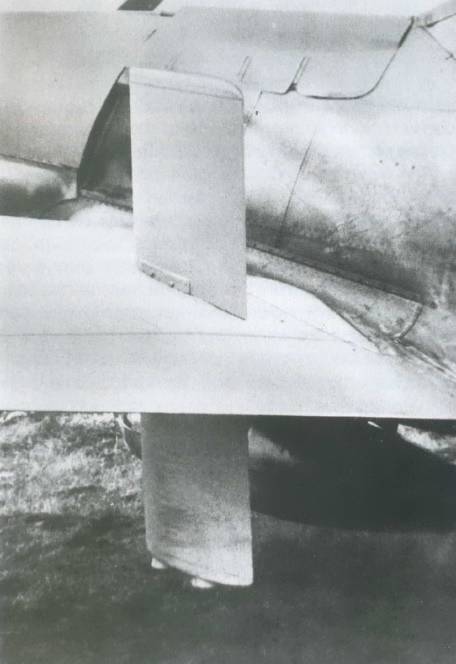
The FW-190 F-8 also tested the SG 113A "Förstersonde" system
General management of the development of this weapon system was carried out at the Graf Zeppelin Research and Testing Center (FGZ) under the guidance of a certified engineer, Professor G. Madelung (G. Madelung). As a carrier of this 18 XANUMX weapon system in January, 1945 used Hs 129 and FW-190 aircraft for testing, and the German Panther tank and T-34 trophy tank were used as experimental targets.
The launch of the missiles was carried out during the flight of airplanes at a height of nine meters above the target. The thickness of the horizontal armor of the tower of the Soviet tank ranged from 17 to 30 mm. During the tests carried out in Rekhlin, the armor of the American tank M4 A3 "Sherman", which had a thickness of 48 mm, was pierced. Vertically mounted launchers sloped backwards in 8 degrees. During the tests, carried out in addition to Rechlin also in Volkenrode (Völkenrode), rocket launches from minimum heights gradually allowed to achieve results in 90% hits. In early February, 1945 equipment was ready for five prototype aircraft. The first such aircraft was prepared for testing in Stuttgart-Ruit (Stuttgart-Ruit). The second aircraft was prepared for testing 6 February 1945 g. At the helm of this aircraft was a graduate engineer Dietrich (Dietrich), who overtook the plane from Langenhagen (Langenhagen), which is near Hanover (Hannover) in Nellingen located near Stuttgart. All necessary equipment for testing was prepared for installation on a second experimental aircraft in the middle of winter, and February 14 1945. the plane was ready for testing by a representative of the Luftwaffe test center Dr. Spengler (Spengler). The FW-190 F-8 was ready for testing several days earlier, but the first test flight was made on February 21 1945. Although the second prototype had more than the first FW-113 F-190 aircraft prepared for testing the SG 8 system, the 27 was carried out during the February 1945 of February. in Boblingen (Boblingen) tests, four missiles were able to hit the captured tank KV-1. The missiles were launched from a height of about 11 meters above the tank. Three of them hit the target, another rocket exploded close to the target. In general, during the tests concluded that this installation can be used in combat. However, it became necessary to improve the missile launch system. The sensor mounts were developed by Wandel & Goltermann, the electrical equipment by Siemens & Halske, the sensors were manufactured at the Graf Zeppelin R&D Center (FGZ). Armament for March 20 1945 manufactured by Rheinmetall-Borsig together with the Luftwaffe Testing Center in Rechlin, and elements for attaching a weapon system were developed by Focke-Wulf. Nevertheless, the use of this weapon system was nevertheless decided to be abandoned, since the Panzerblitz anti-tank missiles were easier to manufacture and, in practice, see Panzerblitz 2 missiles of 8,8 caliber. were able to effectively hit targets with a direct hit. At the same time, another special device was developed at the LFA Aviation Research Center, which received the designation SG 116 “Zellendusche”. To produce this weapon system, the basis of which was vertically mounted 30 mm. MK-103 guns with automatic descent, should also be the firm Rheinmetall-Borsig. The fire of the guns of this system was opened after the signal from the photocell was given, and simultaneously with the shot from the barrel of the gun, the counterweight was thrown back to compensate for the recoil. The SG 116 armament system was installed on at least two FW-190 F-8 aircraft belonging to the fighter group JG / 10. These two vehicles were to be used to train the crews of heavy bombers. In the EK 25 Parchim Luftwaffe test center, the SG 116 SG system was installed on three FW-190 F-8 aircraft. The triggering signal for opening fire was developed at the Graf Zeppelin research and testing center (FGZ). According to F.
Experienced carrier system SG 113A "Förstersonde" with a 300-liter discharged fuel tank suspended under the fuselage (front view)
After 8 in May 1945, the Allies seized the documentation and prototypes of the above-mentioned weapons systems for the subsequent use of these ground-breaking developments, as well as an incalculable number of other promising German weapons systems.
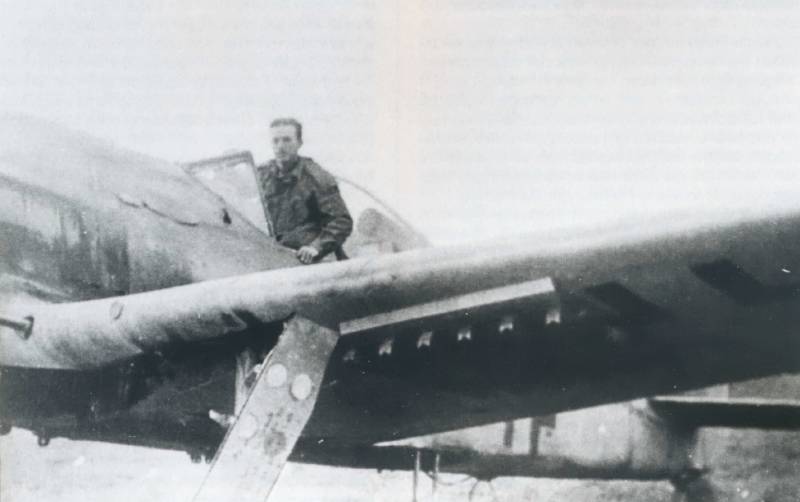
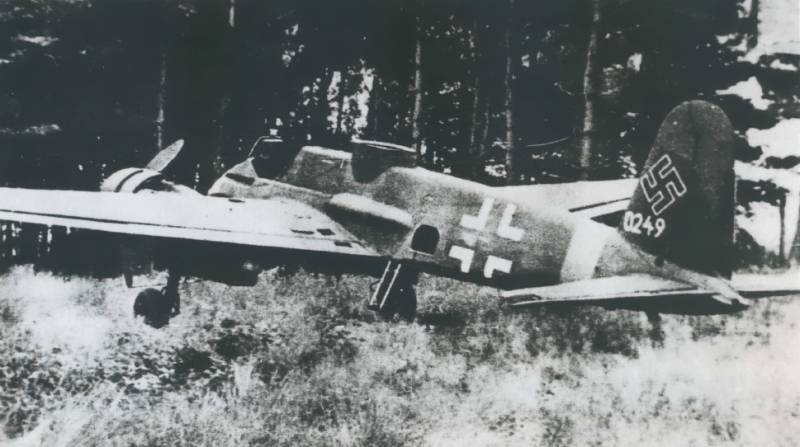
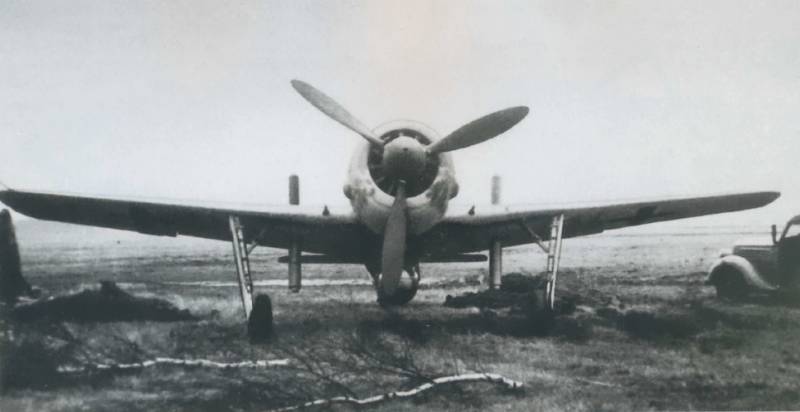
Information